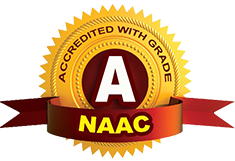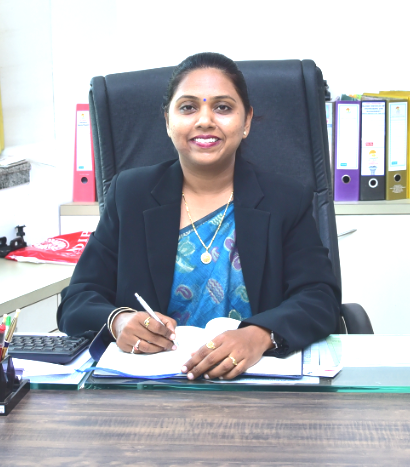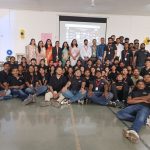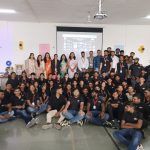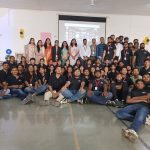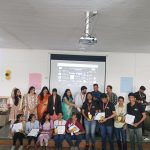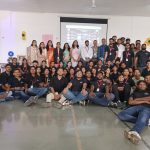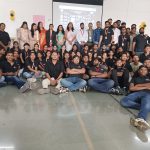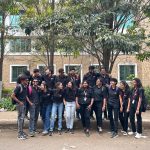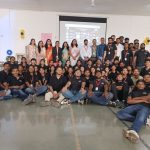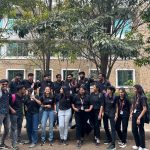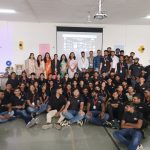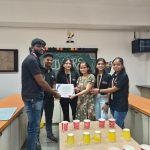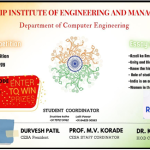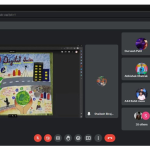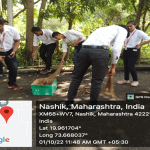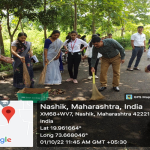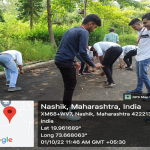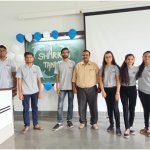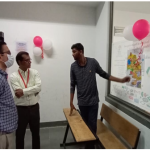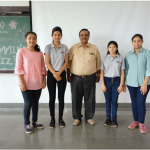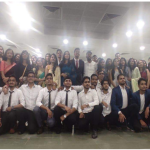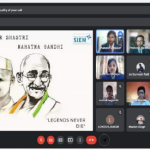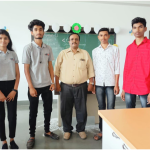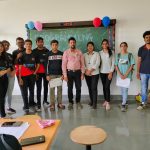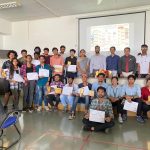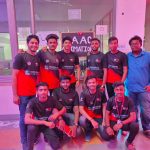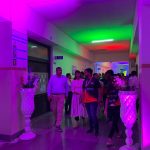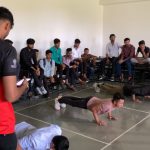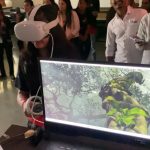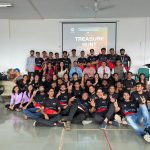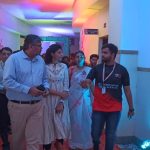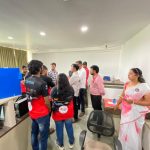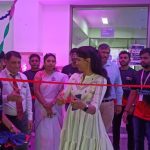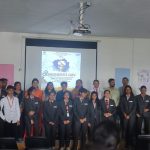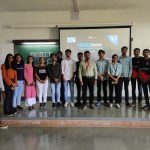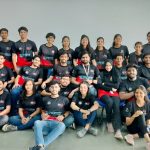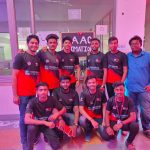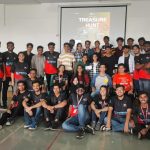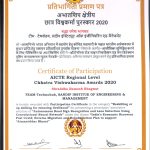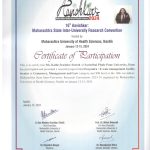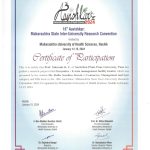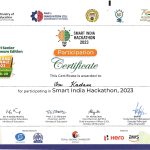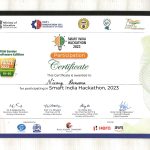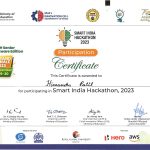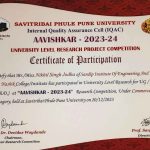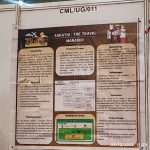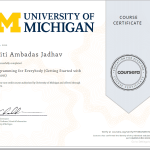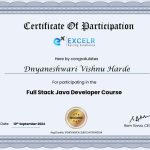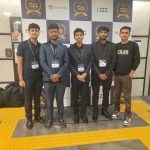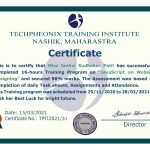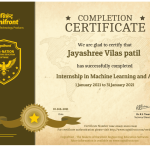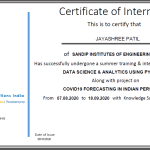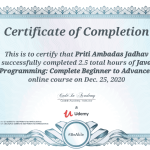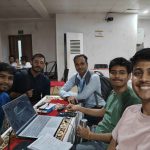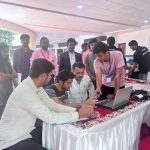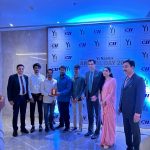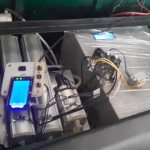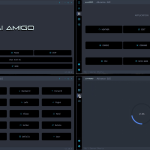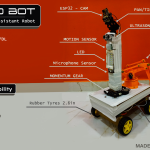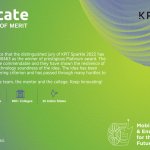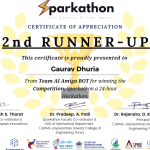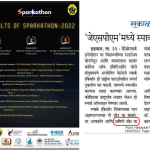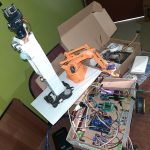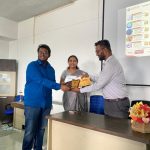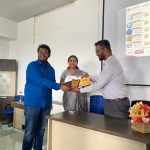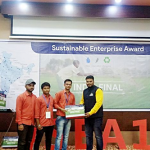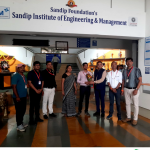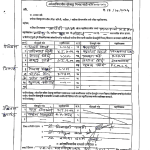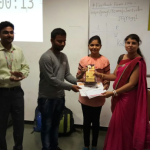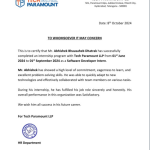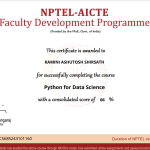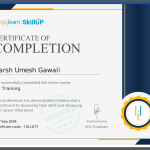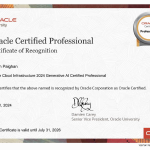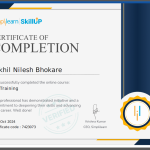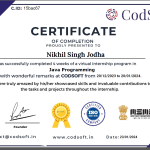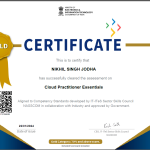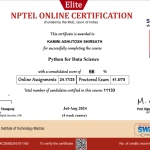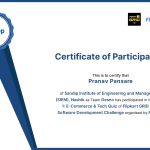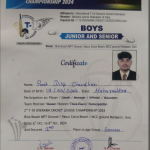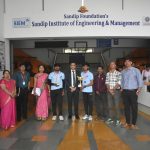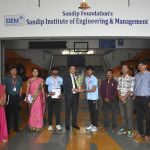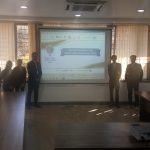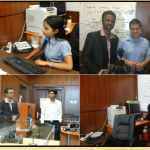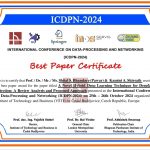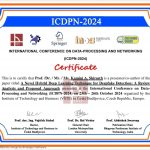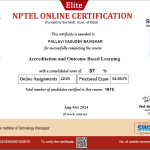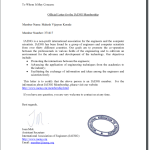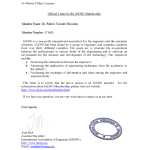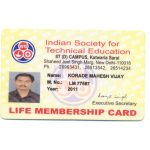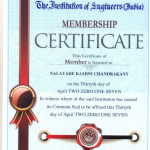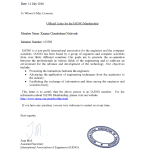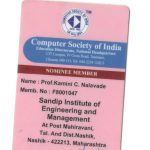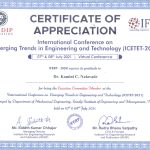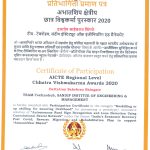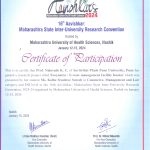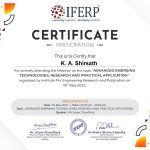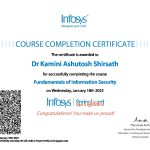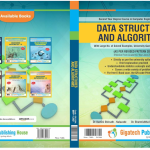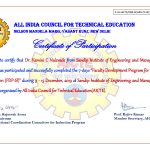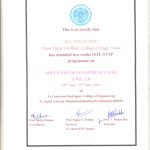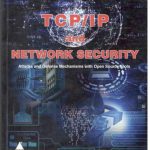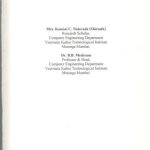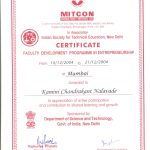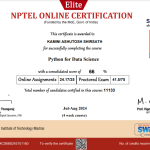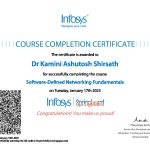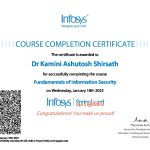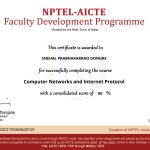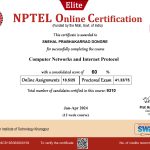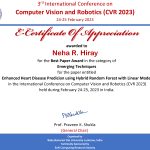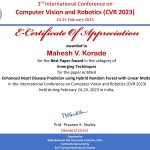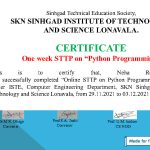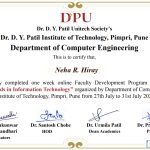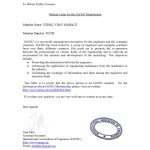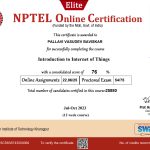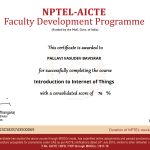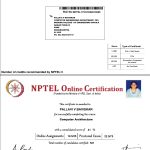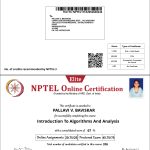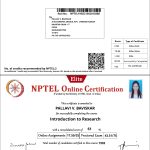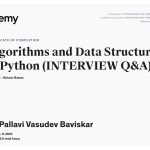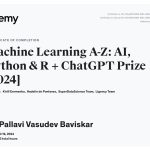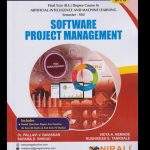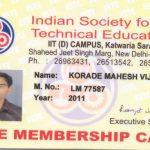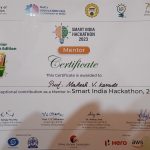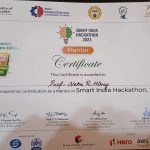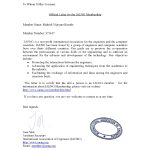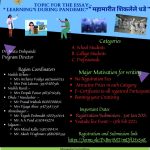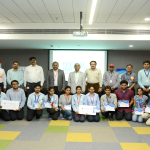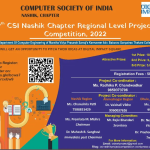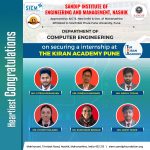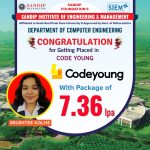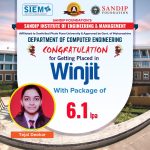Dr. Kamini Ashutosh Shirsath ( Nalavade )
HEAD
Department of Computer Engineering
Mobile: 9673003150
Email: kamini.nalavade@siem.org.in
Computer Engineering
The Department of Computer Engineering sustains and strengthens its teaching and learning program by adapting a comprehensive student centric approach designed to add significant value to the learner in an integrated manner through conceptual and interactive teaching, active lab sessions, seminars, projects, and independent study. As the continued up gradation of the knowledge and skills of faculty members is vital for continuous growth and development of the department, faculties are motivated to attend workshops, seminars, conferences and Training programs.
Department has well equipped state-of-the-art laboratories with latest hardware and software configuration for conducting various practical’s as well as highly qualified and experienced faculty to nurture the future technocrats of the nation.
Vision
The department aims to be recognised in the field of quality education through excellence in teaching, learning, research and innovation for the betterment of society.
Mission
- To provide world class infrastructure with modern tools and technologies for better learning ambiance.
- To enhance problem-solving skills approaches by encouraging young and inspiring minds with innovative teaching & learning.
- To build competent professionals and entrepreneurs through collaborative learning with national and international institutes of repute.
- To contribute in the development of society & nation at large through excellence in research and innovation.
Feedback Form for (Employers/Parents/Alumni/
| Sr. No. | Program Objectives (PO’s) |
|---|---|
| PO 1 | Engineering Knowledge – Apply the knowledge of mathematics, science, engineering fundamentals and basics of computer engineering to identify, formulate & solve. |
| PO 2 | Problem Analysis – Identify, formulate, review and analyze computer hardware and software system. |
| PO 3 | Design/Development of Solutions – Design, implementation and evaluate computer based system as per the needs and specifications. |
| PO 4 | Conduct Investigations of Complex Problems – Use research based knowledge, research methods, analytical methodologies, modern engineering tools and algorithmic approach to analyze and solve complex problems. |
| PO 5 | Modern Tool Usage – To adapt the usage of modern tools and recent software. |
| PO 6 | The Engineer and Society – To contribute towards the society by understanding the impact of Engineering on global aspect |
| PO 7 | Environment and Sustainability – To understand environment issues and design a sustainable system. |
| PO 8 | Ethics – To understand and follow professional ethics. |
| PO 9 | Individual and Team Work – To function effectively as an individual and as member or leader in diverse teams and interdisciplinary settings. |
| PO 10 | Communication – To demonstrate effective communication at various levels. |
| PO 11 | Project Management and Finance – To apply the knowledge of Computer Engineering for development of projects, and its finance and management. |
| PO 12 | Life-Long Learning – To keep in touch with current technologies and inculcate the practice of lifelong learning. |
| Sr. No. | Programme Educational Outcome (PEOs) |
| PEO 1 | To prepare globally competent graduates having strong fundamentals and domain knowledge to provide effective solutions for engineering problems. |
| PEO 2 | To prepare the graduates to work as a committed professionals with strong professional ethics and values, sense of responsibilities, understanding of legal, safety, health, societal, cultural and environmental issues. |
| PEO 3 | To prepare committed and motivated graduates with research attitude, lifelong learning, investigative approach, and multidisciplinary thinking. |
| PEO 4 | To prepare the graduates with strong managerial and communication skills to work effectively as individual as well as in teams. |
Please provide your suggestions on PEO’s of the department of Department on the link given below:
Feedback Form for (Employers/Parents/Alumni/
| Sr. No. | Programme Specific Outcome (PSO) |
|---|---|
|
PSO1 |
Professional Skills-The ability to understand, analyze and develop computer programs in the areas related to algorithms, system software, multimedia, web design, big data analytics, and networking for efficient design of computer-based systems of varying. |
|
PSO2 |
Problem-Solving Skills- The ability to apply standard practices and strategies in software project development using open-ended programming environments to deliver a quality product for business success. |
|
PSO3 |
Successful Career and Entrepreneurship- The ability to employ modern computer languages, environments, and platforms in creating innovative career paths to be an entrepreneur, and a zest for higher studies. |
| Year | Subject And COs | |
|---|---|---|
| SE Sem-I | Course : Discrete Mathematics Course Code: 210241 | |
| Co. No. | Course Outcomes | |
| CO1 | Formulate problems precisely, solve the problems, apply formal proof techniques, and explain the reasoning clearly. | |
| CO2 | Apply appropriate mathematical concepts and skills to solve problems in both familiar and unfamiliar situations including those in real-life contexts. | |
| CO3 | Design and analyze real world engineering problems by applying set theory, propositional logic and to construct proofs using mathematical induction. | |
| CO4 | Specify, manipulate and apply equivalence relations; construct and use functions and apply these concepts to solve new problems. | |
| CO5 | Calculate numbers of possible outcomes using permutations and combinations; to model and analyze computational processes using combinatory | |
| CO6 | Model and solve computing problem using tree and graph and solve problems using appropriate algorithms. | |
| CO7 | Analyze the properties of binary operations, apply abstract algebra in coding theory and evaluate the algebraic structures | |
| Course : Fundamentals of Data Structures Course Code: 210242 | ||
| Co. No. | Course Outcomes | |
| CO1 | Design the algorithms to solve the programming problems, identify appropriate algorithmic strategy for specific application, and analyze the time and space complexity. | |
| CO2 | Discriminate the usage of various structures, Design/Program/Implement the appropriate data structures; use them in implementations of abstract data types and Identity the appropriate data structure in approaching the problem solution. | |
| CO3 | Demonstrate use of sequential data structures- Array and Linked lists to store and process data. | |
| CO4 | Understand the computational efficiency of the principal algorithms for searching and sorting and choose the most efficient one for the application | |
| CO5 | Compare and contrast different implementations of data structures (dynamic and static). | |
| CO6 | Understand, Implement and apply principles of data structures-stack and queue to solve computational problems. | |
| Course : Object Oriented Programming(OOP) Course Code: 210243 | ||
| Co. No. | Course Outcomes | |
| CO1 | Apply constructs- sequence, selection and iteration; classes and objects, inheritance, use of predefined classes from libraries while developing software. | |
| CO2 | Design object-oriented solutions for small systems involving multiple objects. | |
| CO3 | Use virtual and pure virtual function and complex programming situations. | |
| CO4 | Apply object-oriented software principles in problem solving. | |
| CO5 | Analyze the strengths of object-oriented programming. | |
| CO6 | Develop the application using object oriented programming language(C++). | |
| Course :Computer Graphics Course Code: 210244 | ||
| Co. No. | Course Outcomes | |
| CO1 | Identify the basic terminologies of Computer Graphics and interpret the mathematical foundation of the concepts of computer graphics. | |
| CO2 | Apply mathematics to develop Computer programs for elementary graphic operations. | |
| CO3 | Illustrate the concepts of windowing and clipping and apply various algorithms to fill and clip polygons. | |
| CO4 | Understand and apply the core concepts of computer graphics, including transformation in two and three dimensions, viewing and projection. | |
| CO5 | Understand the concepts of color models, lighting, shading models and hidden surface elimination. | |
| CO6 | Create effective programs using concepts of curves, fractals, animation and gaming. | |
| Course : Digital Electronics and Logic Design Course Code: 210245 | ||
| Co. No. | Course Outcomes | |
| CO1 | Simplify Boolean Expressions using K Map. | |
| CO2 | Design and implement combinational circuits. | |
| CO3 | Design and implement sequential circuits. | |
| CO4 | Develop simple real-world application using ASM and PLD. | |
| CO5 | Explain organization and architecture of computer system | |
| CO6 | Students will be able to correctly operate standard electronic test equipment | |
| Course : Data Structures Lab Course Code: 210246 | ||
| Co. No. | Course Outcomes | |
| CO1 | Use algorithms on various linear data structure using sequential organization to solve real life problems. | |
| CO2 | Analyze problems to apply suitable searching and sorting algorithm to various applications. | |
| CO3 | Analyze problems to use variants of linked list and solve various real life problems. | |
| CO4 | Designing and implement data structures and algorithms for solving different kinds of problems. | |
| Course : OOP and Computer Graphics Laboratory Course Code: 210247 | ||
| Co. No. | Course Outcomes | |
| CO1 | Understand and apply the concepts like inheritance, polymorphism, exception handling and generic structures for implementing reusable programming codes. | |
| CO2 | Analyze the concept of file and apply it while storing and retrieving the data from secondary storages. | |
| CO3 | Analyze and apply computer graphics algorithms for line-circle drawing, scan conversion and filling with the help of object oriented programming concepts. | |
| CO4 | Understand the concept of windowing and clipping and apply various algorithms to fill and clip polygons. | |
| CO5 | Apply logic to implement, curves, fractals, animation and gaming programs. | |
| Course : Digital Electronics Laboratory Course Code: 210248 | ||
| CO1 | Understand the working of digital electronic circuits. | |
| CO2 | Apply the knowledge to appropriate IC as per the design specifications. | |
| CO3 | Design and implement Sequential and Combinational digital circuits as per the specifications. | |
| Course : Business Communication Skills Course Code: 210249 | ||
| CO1 | Express effectively through verbal/oral communication and improve listening skills | |
| CO2 | Write precise briefs or reports and technical documents. | |
| CO3 | Prepare for group discussion / meetings / interviews and presentations. | |
| CO4 | Explore goal/target setting, self-motivation and practicing creative thinking. | |
| CO5 | Operate effectively in multi-disciplinary and heterogeneous teams through the knowledge of team work, Inter-personal relationships, conflict management and leadership qualities. | |
| Course : Humanity and Social Science Course Code: 210250 | ||
| CO1 | Aware of the various issues concerning humans and society. | |
| CO2 | Aware about their responsibilities towards society. | |
| CO3 | Sensitized about broader issues regarding the social, cultural, economic and human aspects, involved in social changes. | |
| CO4 | Able to understand the nature of the individual and the relationship between self and the community. | |
| CO5 | Able to understand major ideas, values, beliefs, and experiences that have shaped human history and cultures | |
| SE Sem-II | Course : Engineering Mathematics III Course Code: 207003 | |
| Co. No. | Course Outcomes | |
| CO1 | Solve Linear differential equations, essential in modelling and design of computer-based systems. | |
| CO2 | Apply concept of Fourier transform and Z-transform and its applications to continuous and discrete systems and image processing. | |
| CO3 | Apply Statistical methods like correlation and regression analysis and probability theory for data analysis and predictions in machine learning. | |
| CO4 | Solve Algebraic and Transcendental equations and System of linear equations using numerical techniques. | |
| CO5 | Obtain Interpolating polynomials, numerical differentiation and integration, numerical solutions of ordinary differential equations used in modern scientific computing. | |
| Course : Data Structures and Algorithms Course Code: 210252 | ||
| Co. No. | Course Outcomes | |
| CO1 | Identify and articulate the complexity goals and benefits of a good hashing scheme for real- world applications. | |
| CO2 | Apply non-linear data structures for solving problems of various domain. | |
| CO3 | Design and specify the operations of a nonlinear-based abstract data type and implement them in a high-level programming language. | |
| CO4 | Analyze the algorithmic solutions for resource requirements and optimization | |
| CO5 | Use efficient indexing methods and multiway search techniques to store and maintain data. | |
| CO6 | Use appropriate modern tools to understand and analyze the functionalities confined to the secondary storage. | |
| Course : Software Engineering Course Code: 210253 | ||
| Co. No. | Course Outcomes | |
| CO1 | Analyze software requirements and formulate design solution for a software. | |
| CO2 | Design applicable solutions in one or more application domains using software engineering approaches that integrate ethical, social, legal and economic concerns. | |
| CO3 | Apply new software models, techniques and technologies to bring out innovative and novelistic solutions for the growth of the society in all aspects and evolving into their continuous professional development. | |
| CO4 | Model and design User interface and component-level. | |
| CO5 | Identify and handle risk management and software configuration management. | |
| CO6 | Utilize knowledge of software testing approaches, approaches to verification and validation. | |
| CO7 | Construct software of high quality – software that is reliable, and that is reasonably easy to understand, modify and maintain efficient, reliable, robust and cost-effective software solutions. | |
| Course : Microprocessor Course Code: 210254 | ||
| Co. No. | Course Outcomes | |
| CO1 | Exhibit skill of assembly language programming for the application | |
| CO2 | Classify Processor architectures. | |
| CO3 | Illustrate advanced features of 80386 Microprocessor. | |
| CO4 | Compare and contrast different processor modes. | |
| CO5 | Use interrupts mechanism in applications | |
| CO6 | Differentiate between Microprocessors and Microcontrollers. | |
| CO7 | Identify and analyze the tools and techniques used to design, implement, and debug microprocessor-based systems | |
| Course : Principles of Programming Languages Course Code: 210255 | ||
| Co. No. | Course Outcomes | |
| CO1 | Make use of basic principles of programming languages | |
| CO2 | Develop a program with Data representation and Computations | |
| CO3 | Develop programs using Object Oriented Programming language : Java. | |
| CO4 | Develop application using inheritance, encapsulation, and polymorphism. | |
| CO5 | Demonstrate Multithreading for robust application development. | |
| CO6 | Develop a simple program using basic concepts of Functional and Logical programming paradigm | |
| Course : Data Structures and Algorithms Laboratory Course Code: 210256 | ||
| Co. No. | Course Outcomes | |
| CO1 | Understand the ADT/libraries, hash tables and dictionary to design algorithms for a specific problem. | |
| CO2 | Choose most appropriate data structures and apply algorithms for graphical solutions of the problems. | |
| CO3 | Apply and analyze non linear data structures to solve real world complex problems. | |
| CO4 | Apply and analyze algorithm design techniques for indexing, sorting, multi-way searching, file organization and compression. | |
| CO5 | Analyze the efficiency of most appropriate data structure for creating efficient | |
| Course : Microprocessor Laboratory Course Code: 210257 | ||
| Co. No. | Course Outcomes | |
| CO1 | Understand and apply various addressing modes and instruction set to implement assembly language programs | |
| CO2 | Apply logic to implement code conversion | |
| CO3 | Analyze and apply logic to demonstrate processor mode of operation | |
| Course : Project Based Learning II Course Code: 210258 | ||
| Co. No. | Course Outcomes | |
| CO1 | Identify the real life problem from societal need point of view | |
| CO2 | Choose and compare alternative approaches to select most feasible one | |
| CO3 | Analyze and synthesize the identified problem from technological perspective | |
| CO4 | Design the reliable and scalable solution to meet challenges | |
| CO5 | Evaluate the solution based on the criteria specified | |
| CO6 | Inculcate long life learning attitude towards the societal problems | |
| TE Sem-I | Course : Database Management Systems Course Code: 310241 | |
| Co. No. | Course Outcomes | |
| CO1 | Analyze and design Database Management System using ER model | |
| CO2 | Implement database queries using database languages | |
| CO3 | Normalize the database design using normal forms | |
| CO4 | Apply Transaction Management concepts in real-time situations | |
| CO5 | Use NoSQL databases for processing unstructured data | |
| CO6 | Differentiate between Complex Data Types and analyze the use of appropriate data | |
| Course : Theory of Computation Course Code: 310242 | ||
| Co. No. | Course Outcomes | |
| CO1 | Understand formal language, translation logic, essentials of translation, alphabets, language representation and apply it to design Finite Automata and its variants | |
| CO2 | Construct regular expression to present regular language and understand pumping lemma for RE | |
| CO3 | Design Context Free Grammars and learn to simplify the grammar | |
| CO4 | Construct Pushdown Automaton model for the Context Free Language | |
| CO5 | Devise Turing Machine for the different requirements outlined by theoretical computer science | |
| CO6 | Analyze different classes of problems, and study concepts of NP completeness | |
| Course : Systems Programming and Operating System Course Code: 310243 | ||
| Co. No. | Course Outcomes | |
| CO1 | Decide on a process model for a developing a software project | |
| CO2 | Classify software applications and Identify unique features of various domains | |
| CO3 | Design test cases of a software system. | |
| CO4 | Understand basics of IT Project management. | |
| CO5 | Plan, schedule and execute a project considering the risk management. | |
| CO6 | Apply quality attributes in software development life cycle | |
| Course : Computer Networks and Security Course Code: 310244 | ||
| Co. No. | Course Outcomes | |
| CO1 | Summarize fundamental concepts of Computer Networks, architectures, protocols and technologies | |
| CO2 | Illustrate the working and functions of data link layer | |
| CO3 | Analyze the working of different routing protocols and mechanisms | |
| CO4 | : Implement client-server applications using sockets | |
| CO5 | Illustrate role of application layer with its protocols, client-server architectures | |
| CO6 | Comprehend the basics of Network Security | |
| Course : Internet of Things and Embedded Systems Course Code: 310245(A) | ||
| Co. No. | Course Outcomes | |
| CO1 | Understand the fundamentals and need of Embedded Systems for the Internet of Things | |
| CO2 | Apply IoT enabling technologies for developing IoT systems | |
| CO3 | Apply design methodology for designing and implementing IoT applications | |
| CO4 | Analyze IoT protocols for making IoT devices communication | |
| CO5 | Design cloud based IoT systems | |
| CO6 | Design and Develop secured IoT applications | |
| Course : Database Management Systems Laboratory Course Code: 310246 | ||
| Co. No. | Course Outcomes | |
| CO1 | Design E-R Model for given requirements and convert the same into database tables | |
| CO2 | Design schema in appropriate normal form considering actual requirements | |
| CO3 | Implement NoSQL queries using MongoDB | |
| CO4 | Implement SQL queries for given requirements, using different SQL concepts | |
| CO5 | Implement PL/SQL Code block for given requirements | |
| CO6 | Design and develop application considering actual requirements and using database concepts | |
| Course : Computer Networks and Security Laboratory Course Code: 310247 | ||
| Co. No. | Course Outcomes | |
| CO1 | Analyze the requirements of network types, topology and transmission media | |
| CO2 | Demonstrate error control, flow control techniques and protocols and analyze them | |
| CO3 | Demonstrate the subnet formation with IP allocation mechanism and apply various routing algorithms | |
| CO4 | Develop Client-Server architectures and prototypes | |
| CO5 | Implement web applications and services using application layer protocols | |
| CO6 | Use network security services and mechanisms | |
| Course : Laboratory Practice I Course Code: 310248 | ||
| Co. No. | Course Outcomes | |
| CO1 | Implement language translators | |
| CO2 | Use tools like LEX and YACC | |
| CO3 | Implement internals and functionalities of Operating System | |
| CO4 | Design IoT and Embedded Systems based application | |
| CO5 | Develop smart applications using IoT | |
| CO6 | Develop IoT applications based on cloud environment | |
| Course : Seminar and Technical Communication Course Code: 310249 | ||
| CO1 | Analyze a latest topic of professional interest | |
| CO2 | Enhance technical writing skills | |
| CO3 | Identify an engineering problem, analyze it and propose a work plan to solve it | |
| CO4 | Communicate with professional technical presentation skills | |
| TE Sem-II | Course :Data Science and Big Data Analytics Course Code: 310251 | |
| Co. No. | Course Outcomes | |
| CO1 | Analyze needs and challenges for Data Science Big Data Analytics | |
| CO2 | Apply statistics for Big Data Analytics | |
| CO3 | Apply the lifecycle of Big Data analytics to real world problems | |
| CO4 | Implement Big Data Analytics using Python programming | |
| CO5 | Implement data visualization using visualization tools in Python programming | |
| CO6 | Design and implement Big Databases using the Hadoop ecosystem | |
| Course : Web Technology Course Code:310252 | ||
| Co. No. | Course Outcomes | |
| CO1 | Implement and analyze behavior of web pages using HTML and CSS | |
| CO2 | Apply the client side technologies for web development | |
| CO3 | Analyze the concepts of Servlet and JSP | |
| CO4 | Analyze the Web services and frameworks | |
| CO5 | Apply the server side technologies for web development | |
| CO6 | Create the effective web applications for business functionalities using latest web development platforms | |
| Course : Artificial Intelligence Course Code: 310253 | ||
| Co. No. | Course Outcomes | |
| CO1 | Identify and apply suitable Intelligent agents for various AI applications | |
| CO2 | Build smart system using different informed search / uninformed search or heuristic approaches | |
| CO3 | Identify knowledge associated and represent it by ontological engineering to plan a strategy to solve given problem | |
| CO4 | Apply the suitable algorithms to solve AI problems | |
| CO5 | Implement ideas underlying modern logical inference systems | |
| CO6 | Represent complex problems with expressive yet carefully constrained language of representation | |
| Course :Information Security Course Code: 310254 (A) | ||
| Co. No. | Course Outcomes | |
| CO1 | Model the cyber security threats and apply formal procedures to defend the attacks | |
| CO2 | Apply appropriate cryptographic techniques by learning symmetric and asymmetric key cryptography | |
| CO3 | Design and analyze web security solutions by deploying various cryptographic techniques along with data integrity algorithms | |
| CO4 | Identify and Evaluate Information Security threats and vulnerabilities in Information systems and apply security measures to real time scenarios | |
| CO5 | Demonstrate the use of standards and cyber laws to enhance Information Security in the | |
| Course :Internship Course Code: 310255 | ||
| Co. No. | Course Outcomes | |
| CO1 | To demonstrate professional competence through industry internship | |
| CO2 | To apply knowledge gained through internships to complete academic activities in a professional manner | |
| CO3 | To choose appropriate technology and tools to solve given problem. | |
| CO4 | To demonstrate abilities of a responsible professional and use ethical practices in day to day life. | |
| CO5 | Creating network and social circle, and developing relationships with industry people | |
| CO6 | To analyze various career opportunities and decide carrier goals. | |
| Course :Data Science and Big Data Analytics Laboratory Course Code: 310256 | ||
| Co. No. | Course Outcomes | |
| CO1 | Apply principles of Data Science for the analysis of real time problems | |
| CO2 | Implement data representation using statistical methods | |
| CO3 | Implement and evaluate data analytics algorithms | |
| CO4 | Perform text preprocessing | |
| CO5 | Implement data visualization techniques | |
| CO6 | Use cutting edge tools and technologies to analyze Big Data | |
| Course :Web Technology Laboratory Course Code: 310257 | ||
| Co. No. | Course Outcomes | |
| CO1 | Understand the importance of website planning and website design issues | |
| CO2 | Apply the client side and server side technologies for web application development | |
| CO3 | Analyze the web technology languages, frameworks and services | |
| CO4 | Create three tier web based applications | |
| Course :Laboratory Practice II Course Code:310258 | ||
| Co. No. | Course Outcomes | |
| CO1 | Design a system using different informed search / uninformed search or heuristic approaches | |
| CO2 | Apply basic principles of AI in solutions that require problem solving, inference, perception, knowledge representation, and learning | |
| CO3 | Design and develop an interactive AI application | |
| CO4 | Use tools and techniques in the area of Information Security | |
| CO5 | Use the cryptographic techniques for problem solving | |
| CO6 | Design and develop security solution | |
| BE Sem-I | Course : Design and Analysis of Algorithms Course Code: 410241 | |
| Co. No. | Course Outcomes | |
| CO1 | Formulate the problem | |
| CO2 | Analyze the asymptotic performance of algorithms | |
| CO3 | Decide and apply algorithmic strategies to solve given problem | |
| CO4 | Find optimal solution by applying various methods | |
| CO5 | Analyze and Apply Scheduling and Sorting Algorithms | |
| CO6 | Solve problems for multi-core or distributed or concurrent environments | |
| Course :Machine Learning Course Code: 410242 | ||
| Co. No. | Course Outcomes | |
| CO1 | Identify the needs and challenges of machine learning for real time applications. | |
| CO2 | Apply various data pre-processing techniques to simplify and speed up machine learning algorithms | |
| CO3 | Select and apply appropriately supervised machine learning algorithms for real time applications | |
| CO4 | Implement variants of multi-class classifier and measure its performance. | |
| CO5 | Compare and contrast different clustering algorithms. | |
| CO6 | Design a neural network for solving engineering problems | |
| Course: Blockchain Technology Code: 410243 | ||
| Co. No. | Course Outcomes | |
| CO1 | Interpret the fundamentals and basic concepts in Blockchain | |
| CO2 | Compare the working of different blockchain platforms | |
| CO3 | Use Crypto wallet for cryptocurrency based transactions | |
| CO4 | Analyze the importance of blockchain in finding the solution to the real-world problems. | |
| CO5 | Illustrate the Ethereum public block chain platform | |
| CO6 | Identify relative application where block chain technology can be effectively used andimplemented. | |
| Course : Elective-III (Cyber Security and Digital Forensics) Course Code: 410244(C) | ||
| Co. No. | Course Outcomes | |
| CO1 | Analyze threats in order to protect or defend it in cyberspace from cyber-attacks. | |
| CO2 | Build appropriate security solutions against cyber-attacks. | |
| CO3 | Underline the need of digital forensic and role of digital evidences. | |
| CO4 | Explain rules and types of evidence collection | |
| CO5 | Analyze, validate and process crime scenes | |
| CO6 | Identify the methods to generate legal evidence and supporting investigation reports. | |
| Course : Elective-IV (Software Testing and Quality Assurance) Course Code: 410245D | ||
| Co. No. | Course Outcomes | |
| CO1 | Describe fundamental concepts in software testing such as manual testing, automation testingand software quality assurance | |
| CO2 | Design and Develop project test plan, design test cases, test data, and conduct test operations. | |
| CO3 | Apply recent automation tool for various software testing for testing software. | |
| CO4 | Apply different approaches of quality management, assurance, and quality standard to softwaresystem | |
| CO5 | Apply and analyze effectiveness Software Quality Tools. | |
| CO6 | Apply tools necessary for efficient testing framework | |
| Course : Laboratory Practice III Course Code: 410246 | ||
| CO1 | Apply preprocessing techniques on datasets. | |
| CO2 | Implement and evaluate linear regression and random forest regression models. | |
| CO3 | Apply and evaluate classification and clustering techniques. | |
| CO4 | Analyze performance of an algorithm. | |
| CO5 | Implement an algorithm that follows one of the following algorithm design strategies: divide and conquer, greedy, dynamic programming, backtracking, branch and bound | |
| CO6 | Interpret the basic concepts in Blockchain technology and its applications | |
| Course : Laboratory Practice IV Course Code: 410247 | ||
| CO1 | Apply android application development for solving real life problems | |
| CO2 | Design and develop system using various multimedia components. | |
| CO3 | Identify various vulnerabilities and demonstrate using various tools. | |
| CO4 | Apply information retrieval tools for natural language processing | |
| CO5 | Develop an application using open source GPU programming languages | |
| CO6 | Apply software testing tools to perform automated testing | |
| Course : Project Work Stage I Course Code: 410248 | ||
| CO1 | · Solve real life problems by applying knowledge. | |
| CO2 | · Analyze alternative approaches, apply and use most appropriate one for feasible solution. | |
| CO3 | · Write precise reports and technical documents in a nutshell. | |
| CO4 | · Participate effectively in multi-disciplinary and heterogeneous teams exhibiting team work | |
| CO5 | Inter-personal relationships, conflict management and leadership quality | |
| BE Sem-II | Course : High Performance Computing Code: 410250 | |
| Co. No. | Course Outcomes | |
| CO1 | : Understand various Parallel Paradigm | |
| CO2 | : Design and Develop an efficient parallel algorithm to solve given problem | |
| CO3 | Illustrate data communication operations on various parallel architecture | |
| CO4 | Analyze and measure performance of modern parallel computing systems | |
| CO5 | Apply CUDA architecture for parallel programming | |
| CO6 | Analyze the performance of HPC applications | |
| Course : Deep Learning Course Code: 410251 | ||
| Co. No. | Course Outcomes | |
| CO1 | Understand the basics of Deep Learning and apply the tools to implement deep learningapplications | |
| CO2 | Evaluate the performance of deep learning models (e.g., with respect to the bias-variance trade- off, overfitting and underfitting, estimation of test error). | |
| CO3 | To apply the technique of Convolution (CNN) and Recurrent Neural Network (RNN) forimplementing Deep Learning models | |
| CO4 | To implement and apply deep generative models. | |
| CO5 | Construct and apply on-policy reinforcement learning algorithms | |
| CO6 | To Understand Reinforcement Learning Process | |
| Course :Elective-V (Software Defined Networks) Course Code: 410252C | ||
| Co. No. | Course Outcomes | |
| CO1 | Interpret the need of Software Defined networking solutions | |
| CO2 | Analyze different methodologies for sustainable Software Defined Networkingsolutions | |
| CO3 | Select best practices for design, deploy and troubleshoot of next generation networks. | |
| CO4 | Develop programmability of network elements. | |
| CO5 | Demonstrate virtualization and SDN Controllers using Open Flow protocol | |
| CO6 | Design and develop various applications of SDN | |
| Course : Elective-VI Business Intelligence) Course Code: 410253C | ||
| Co. No. | Course Outcomes | |
| CO1 | Differentiate the concepts of Decision Support System & Business Intelligence | |
| CO2 | Use Data Warehouse & Business Architecture to design a BI system. | |
| CO3 | :Build graphical reports | |
| CO4 | Apply different data preprocessing techniques on dataset | |
| CO5 | Implement machine learning algorithms as per business needs | |
| CO6 | Identify role of BI in marketing, logistics, and finance and telecommunication sector | |
| Course :Laboratory Practice V Course Code: 410255 | ||
| CO1 | Analyze and measure performance of sequential and parallel algorithms. | |
| CO2 | Design and Implement solutions for multicore/Distributed/parallel environment | |
| CO3 | Identify and apply the suitable algorithms to solve AI/ML problems | |
| CO4 | Apply the technique of Deep Neural network for implementing Linear regression andclassification. | |
| CO5 | Apply the technique of Convolution (CNN) for implementing Deep Learning models. | |
| CO6 | Design and develop Recurrent Neural Network (RNN) for prediction | |
| Course :Laboratory Practice V Course Code: 410256 | ||
| CO1 | Apply basic principles of elective subjects to problem solving and modeling. | |
| CO2 | Use tools and techniques in the area of software development to build mini projects | |
| CO3 | Design and develop applications on subjects of their choice | |
| CO4 | Generate and manage deployment, administration & security. | |
| Course : Project Work Stage II Course Code: 410256 | ||
| CO1 | Show evidence of independent investigation | |
| CO2 | Critically analyze the results and their interpretation | |
| CO3 | Report and present the original results in an orderly way and placing the open questions in the right perspective | |
| CO4 | Link techniques and results from literature as well as actual research and future research lines with the research | |
| CO5 | Appreciate practical implications and constraints of the specialist subject | |
Computer Engineering Students Association Website: www.cesasiem.com
Computer Engineering Students Association (CESA) for A.Y. 2024-2025
| Sr no. | Post | Student Name |
|---|---|---|
| 1 | President | Harsh Yadav |
| 2 | Vice President | Rohan Mahajan |
| 3 | Ladies Representative | Charulata Sonar |
| 4 | Treasurer | Nisarg Pansora |
| 5 | Secretory | Harsh Gawali |
| 6 | Joint Secretory | Rushikesh Landge |
| 7 | Cultural Coordinator | Manas Kamble |
| 8 | Discipline Coordinator | Ganesh Rodge |
- Computer Engineering Students Association (CESA) A.Y. 2023-2024
- Computer Engineering Students Association (CESA) A.Y. 2022-2023
- Computer Engineering Students Association (CESA) A.Y. 2021-2022
- Computer Engineering Students Association (CESA) A.Y. 2020-2021
CESA Event Gallery
Alumni List
Alumni Meet
Alumni Talk
Alumni Testimonials

Ajaykumar Vishwakarma, (Computer Engineering), Passout year 2021
placed In Winjit Technology, (Package –3.01 Lakhs per annum)Currently I am placed at Winjit Technology Pvt Ltd. All thanks to the wonderful guidance of the professors and the Training and placement officers. Achieving such a milestone wouldn’t have been possible otherwise.

Ishwari Deepak Thakur, (Computer Science), Passout year 2021
placed In Winjit Technologies, (Package –3 Lakhs per annum)I am placed at Winjit Technologies - India’s leading provider of innovative engineering solutions. I am grateful for the wonderful guidance and support of the Professors and the Training and Placement officers. This achievement would not have been possible without your encouragement. Thank You for motivating me to achieve such a Milestone.

Bhavika Jain, (B.E Computer Engineering), Passout year 2021
placed In Capgemini, (Package –3.8Lakhs per annum)Currently I am placed at 3 companies namely Capgemini, Winjit, Casepoint. All thanks to the wonderful guidance of the professors and the Training and placement officers. Achieving such a milestone wouldn’t have been possible otherwise.

Janhavi Satish Badgujar, (B.E Computer Engineering), Passout year 2021
placed In Thinkitive Technologies, (Package –4.2 Lakhs per annum)Currently I am placed at 2 companies namely Thinkitive Technologies and Mphasis. All thanks to the wonderful guidance of the professors and the Training and placement officers. Achieving such a milestone wouldn’t have been possible otherwise.

Janhavi Jayant Raut, (B.E Computer Engineering), Passout year 2021
placed In Wipro, (Package –3.5 Lakhs per annum)Currently I am placed at 3 companies namely Wipro, Atos global and GeoSpatial design lab. I would like to express my thankfulness to great professors and the Training and placement officers to give wonderful guidance and encouragement. It was really helpful to achieve this.

Sakshi Mangesh Junnare (B.E Computer Engineering), Passout year 2021
placed In Capgemini, (Package –3.8 Lakhs per annum)Currently I am placed at 3 companies namely Capgemini, Thinkitive Technologies, Casepoint. I would like to give special thanks to all my teachers, mentors for not only helping in my studies but also for enhancing my career. Getting placed in various companies is only possible because of proper guidance, motivation, encouragement and good values that I got from my professors.

Tushar Ramesh Nika . (B.E Computer Engineering), Passout year 2021
placed In Mind sports league (Package – 4.8 Lakhs per annum)Dearly respected teachers, The last four years have flown by so quickly! I still remember being a shy new college student in the freshman dorms. You were one of the few professors who offered extended office hours, remembered each of your student's names, and were seriously invested in every single one of us being successful. You were always reminding us that had what it takes to reach our goals as long as we worked hard, reached out for help when we needed it, and stayed motivated and on track. Just because of all of us I am able to get a job in a product-based company. Thank you so much for being an incredible professor!

Tejal Dinkar Nerpagar. (B.E Computer Engineering), Passout year 2021
placed In Accenture (Package – 4.5 Lakhs per annum)Due to moral support and guidance to all the faculty members, I got placed in 3 companies namely Accenture, TCS and Saama Technologies. I really had a great time and learnt so much along the way. Thank you all for being so helpful, friendly and encouraging throughout this journey.
About CSI
About Computer Society of India

Formed in 1965, the CSI has been instrumental in guiding the Indian IT industry down the right path since its formative years. Today, the CSI has 66 chapters all over India, 381 student branches, and more than 50,000 members, including India’s most famous IT industry leaders, brilliant scientists and dedicated academicians. Now, you have the opportunity to be a part of this distinguished fraternity too.
The mission of the CSI is to facilitate research, knowledge sharing, learning and career enhancement for all categories of IT professionals, while simultaneously inspiring and nurturing new entrants into the industry and helping them to integrate into the IT community. The CSI is also working closely with other industry associations, government bodies and academia to ensure that the benefits of IT advancement ultimately percolate down to every single citizen of India.
For more information visit: http://www.csi-india.org
About CSI - Nashik Chapter
- Nashik chapter of Computer Society of India (CSI) was formed in 1988-89. During the years, the chapter conducted several activities. We have won the Best Chapter award several times.
- Status of Chapter membership as of March 2020
- These student branches have won “Best Student Award” many time.
| Total Members | 151 |
| Life members | 142 |
| Institutional members | 29 |
| Corporate member | 01 |
| Institutional nominee’s | 87 |
| Student braches | 15 |
| Student members | 1440 |
| Fellow member | 01 |
| Patron members | 12 |
- The First student branch was formed in 1992, Today there are more than 20 student branches in and around in Nashik
- Our ACCESS has won the Best Newsletter Award several times.
- The student branch was formed in 1992. It has won the Best Student Branch award.
- CSI, Nashik chapter and its student branch conducts several activities such as seminars, workshops, various competitions throughout the year. Many of the activities such as IT Quiz, Essay and Project Competitions are the regular activities conducted every year by the chapter.
- Chapter runs of computer books. A separate section has been formed for the benefit of school children.
- The chapter holds every alternate year.
- We organise computer awareness lecture programmes for computer sciencestudents in schools and colleges, in Nashik district.
- We have been publishing a monthly bulletin “ACCESS”for last 6 years. The bulletin has been the recipient of the best magazine award twice.
- We conduct essay competitionfor School, College Students and IT Professionals
- The chapter also conduct IT Quiz Contestfor college students and the response has been very good.
- We conduct coursesfor employees.
- CSI is also active in developements of Software Technology Park in Nashik. CSI is also active in arranging the Seminar & Conferences for the STP in Nashik.
- Project Competition organized by CSI-Nashik Chapter in Association with DISQ Nashik for providing a platform to the students to showcase their Project Idea and Model. Selected Project Idea & Model will be awarded and assigned mentors to convert this Project into Product and to form a Business Firm.
Events
Nashik Biggest E-Waste Collection
In today’s techno-savvy world, while we allow exposure of knowledge to the upcoming generation, we are also generating a by-product monster, i.e. Electronic Waste. This is being generated during use of various electronic and electrical gadgets. Handling of E-waste in unscientific methods, gives rise to Air, water and Soil pollution, which intern boom-rang on human and environmental health. As a responsible citizen, we must sensitize present as well as upcoming generation about responsible E-waste management E-yantran is a collaborative initiative of different organizations in Nashik, to sensitize people about E-waste, and its scientific management. As a part of it, we appeal to all institutions, academic institutions, industries to come forward and lend a helping hand in a mega e-waste collection drive happening on 24 to 26 Jan. 2023 with joint efforts of CSI- Nashik Chapter and Poornam Ecovision Foundation, Pune. We are also looking forward to get the support from Nasik Municipal Corporation.
We will be providing all necessary IEC material for E-waste awareness campaign, necessary voluntary orientation. We will be arranging the transport from the collection centers as well. Your efforts in this drive will be acknowledged with appropriate certification. We appeal that your institute should register as a collection center and representatives from your institute should register as volunteers. Kindly note the program structure as below.
|
Collection Center registration: Till 5th Jan 2023 Registration link : https://forms.gle/TrpZMjmh73geLFmt6 |
Volunteer registration: Till 5th Jan 2023 Registration link : |
| Volunteer orientation session: 1st to 5th Jan 2023 | Awareness Campaign Period : 12 to 23 Jan 2023 |
|
Donors to donate e-Waste at Collection Centers – 24-25-26 Jan 2023 |
Pick up by Poornam from Collection Centers – 26th Jan 2023 |
In case of any queries from your side, kindly feel free to contact the Project coordinator Dr. R. D. Kulkarni at email: csinsk.ewaste2023@gmail.com and contact no: 9011896681.
Knowledge Sharing Series
Articles
| Article 666 | 4th December 2023 | View |
| Article 665 | 11th SEPTEMBER 2023 | View |
| Article 664 | 4th SEPTEMBER 2023 | View |
| Article 663 | 28th AUGUST 2023 | View |
| Article 662 | 21st AUGUST 2023 | View |
| Article 661 | 14th AUGUST 2023 | View |
| Article 660 | 7th AUGUST 2023 | View |
| Article 659 | 31st JULY 2023 | View |
| Article 658 | 24th JULY 2023 | View |
| Article 657 | 17th JULY 2023 | View |
| Article 656 | 10th JULY 2023 | View |
| Article 655 | 3rd JULY 2023 | View |
| Article 654 | 26th JUNE 2023 | View |
| Article 653 | 19th JUNE 2023 | View |
| Article 652 | 12th JUNE 2023 | View |
| Article 651 | 5th JUNE 2023 | View |
| Article 655 | 29th MAY 2023 | View |
CSI Team
| S.N. | Name | Designation |
|---|---|---|
| 1 | Dr.Kamini Ashutosh Shirsath | Head of Department |
| 2 | Mr. Vishal V. Mahale | Coordinator |
| 3 | Dr.Pallavi V. Baviskar | Faculty Member |
| 4 | Mr. Nikhil Singh Jodha | Student Member |
| 5 | Mr. Amit V. Arote | Student Member |
| 6 | Ms. Sakshi Shinde | Student Member |

